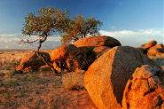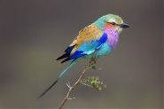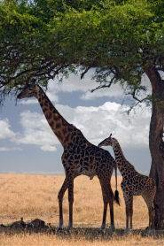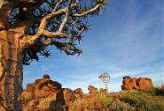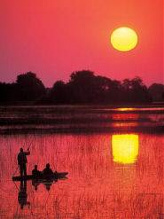
BOOK NOW AND ONLY PAY 5% DEPOSIT
Simply click on the destination name for information on lodges, hotels and camping in Namibia. Tel +27 (0) 21 8550395



BOOK NOW AND ONLY PAY 5% DEPOSIT
Simply click on the destination name for information on lodges, hotels and camping in Namibia. Tel +27 (0) 21 8550395


Distances in Namibia can be misleading. It will take approximately 1 hour to drive 90km on main roads and 90 min to do the same distance on gravel roads.

Indication of the weather that you can expect.

Namibia, a land of contrasts and diversities, derives its name from the oldest desert in the world, the Namib Desert.
Bordered by South Africa to the south, Botswana to the east, and Angola to the north, Namibia boasts a rich tapestry of landscapes. Along the western coastal belt lies ever-shifting high sand dunes, some of which are considered to be the highest in the world. The waters of the cold Benguela current that runs down the western side of Namibia are very rich in marine life, providing wonderful fishing opportunities. Inland, the range of landscapes and climatic conditions varies from deserts to rolling grass plains, savannahs, and forested regions. The northern part of Namibia's coastline is known as the Skeleton Coast.
With a sparse population of just 3.2 persons per square kilometre, Namibia offers vast stretches of wilderness and farmlands.
This stunning country boasts the largest free-roaming herds of black rhinos and is home to the only desert-adapted elephants, which are found in only one other part of the world. Additionally, Namibia is home to the largest cheetah population on the planet.
A must-see in Namibia is the Fish River Canyon, the largest canyon in Africa, stretching 160 km long, 27 km wide, and in some places, over half a kilometre deep.
When it comes to accommodation, Namibia offers a wide range, from basic self-catering chalets to luxurious hotels. From Etosha to Damaraland, and from the Namib to the Kalahari, you will find the finest lodges and campsites to suit every taste and budget.
Most visitors to Namibia use Windhoek International Airport as their starting point. In Windhoek, the capital city, there are various hotel options. Notably, the well-known Windhoek Casino and Country Club stands as the only 5-star hotel in the area. Situated just south of the capital, this hotel boasts an 18-hole golf course.
For those who prefer the central business district, the Windhoek Safari Hotel comprising three hotels on one estate, is a great option. The Safari Hotel provides excellent value for money, while the Windhoek Safari Court combines luxury and affordability. If self-catering accommodation is preferred, Arrebusch Lodge in the city, or Monteiro 10 km south of Windhoek is the perfect solution.
Moving east, Gobabis lies 200 km from Windhoek, not far from the Botswana border. It is a cattle farming area and also hosts various game farms, such as the Harnas Sanctuary in the Gobabis district. For a comfortable stay, Goba Lodge is an excellent choice for a day or two or simply as an overnight stop for travellers en route to Botswana. Other options include Zelda Guestfarm and the East Gate Lodge, which offers basic self-catering accommodation for the weary traveller.
Heading south from Windhoek, vast desert areas await discovery, with highlights such as Sossusvlei and the Fish River Canyon captivating adventurous travellers. Many South African visitors opt to cover the vast distances in their own vehicles or by renting one. The first town encountered on the journey from South Africa is Noordoewer, named after its situation on the northern banks of the Orange River. Visitors can stay at Norotshama and explore farming activities and see vineyards that end abruptly in the rocky gravel plains of the adjacent barren Namib desert. For an overnight stay or some canoeing on the river, Orange River Lodge offers self-catering chalet accommodation.
Continuing northwest from Noordoewer, the Richtersveld Transfrontier Park lies, home to the world's second-largest canyon, adding to Namibia's geological paradise. Visitors can stay at the hot water springs at Ai-Ais or explore the stunning rock formations and view the Fish River Canyon. Accommodation options include CaÑon Lodge and CaÑon Village, both situated on the western rim of the canyon.
The central area, sandwiched between the Namib Desert to the west and the Kalahari Desert to the east, hosts hardened cattle and sheep farmers who eke out a living on the harsh scrub plains.
As one of the oldest deserts in the world, the Namib boasts mountainous sand dunes, attracting photographers from all over the world. The sand dunes at Sossusvlei are the highest in the world and provide an unforgettable experience, especially in the early morning when the shadow contrasts make for stunning photos. For an immersive experience, Desert Dune Lodge within the park offers luxurious accommodation, while Sossusvlei Lodge is a great choice for those seeking real desert luxury. For self-catering options, Desert Camp is recommended.
Wandering and discovering the fascinating desert on gravel roads for a few days is a popular choice, with a wide variety of accommodation options available. Namib Desert Lodge and Solitaire to the north, and Desert Homestead and Elegant Desert Lodge to the south are just a few examples. Helmeringhausen Hotel lies en route to Luderitz.
Luderitz, a small harbour town, is best known for its diamond exploration in the early 1900s. Today, diamond mining activities are less, and access is restricted in the diamond concession areas. Ghost towns like Kolmanskop near Luderitz bear testimony to the bygone era of diamond mining. The German influence is evident in Luderitz, with captivating older buildings in the typical German style. Accommodation options include Pension Zur Waterkant, The Cormorant House and The Nest Hotel which offers breathtaking views over Luderitz Bay.
Namibia's main highway, running north to south, is a good tar road with hardly any twists or turns. Along this road, you'll find the small town of Grunau to the south, at the centre of a sheep farming area. Grunau Country House offers hotel-type accommodation, while Grunau Chalets provides self-catering options for travellers seeking a break from the long, dusty journey.
North of Grunau lies Keetmanshoop, Namibia's 5th largest town and the unofficial capital of Southern Namibia. Keetmanshoop offers accommodation at Maritz Country Lodge. For those seeking a natural reserve experience, Quivertree Lodge situated in a quiver tree reserve, offers self-catering accommodation with meal options. Hotel accommodation can be found at Canyon Hotel in Keetmanshoop.
About 200 km north of Keetmanshoop is Mariental, a fairly small town that still provides accommodations such as Hardapdam and Mariental River Chalets. Despite its name, the Fish River is dry for most of the year, and the broad sandy riverbed might not look like a river at all to most visitors. Approximately 80 km from Mariental, in the Kalahari, is Intu Africa, a nature reserve and home to the San or Bushmen.
For travellers exploring the northern regions of Namibia, Windhoek is the starting point. The journey may be filled with dreamy wanderings, but rest assured, it's the road to adventure. Windhoek lies in a natural basin between attractive thorn trees and grass-covered hills.
Heading north of Windhoek, visitors reach Okahandja, a cattle farming district. The Okahandja Country Lodge offers a pleasant hotel experience on the outskirts of Okahandja, providing a cool stopover or a restful place for a meal.
For those dreaming of witnessing the wild Skeleton Coast, a westward turn leads to Karibib and Usakos before reaching Swakopmund, Namibia's best-known coastal resort. The German colonial era is evident in many older buildings, such as The Swakopmund Hotel, a luxury hotel housed in an attractive old station building, complete with a casino. Other accommodation options include Sams Giardino Hotel, Hotel Eberwein, Hotel Pension Rapmund and the luxurious Hansa Hotel all offering excellent German-style service. The Beach Hotel is a stylish modern hotel with breathtaking views over the windswept beach. For a unique experience, The Stiltz Lodge is built on poles over the reed beds in the mouth of the Swakop River, boasting abundant bird life. For budget travellers, Swakopmund Municipal Restcamp provides reasonably priced self-catering chalets, while Alte Brucke offers a more up-market self-catering option.
The Skeleton Coast is renowned for outstanding beach fishing. Henties Bay, Swakopmund, and Walvis Bay are top angling destinations, with lodges and hotels catering to eager fishermen. Fishermans Guesthouse offers fishing expeditions and De Duine Hotel is a popular local pub providing hotel rooms and excellent meals.
The Skeleton Coast earned its name from numerous shipwrecks that occurred due to the lack of fresh water in this desolate area in previous years. The astonishing Cape Cross Lodge stands in stark contrast to the harsh conditions, offering excellent meals and up-market accommodation. Despite the challenging environment, animals still roam these areas, with desert jackals and brown hyenas adapted to survive without water. Visitors can also witness one of the largest Seal Colonies along the Namibian coasts near Cape Cross Lodge. The Cape Cross Seal Colony opens its entrance gate at 10 am daily for visitors.
Continuing from the Skeleton Coast National Park, the journey usually leads inland to Damaraland, known for its semi-desert environment featuring gnarled Mopane trees, twisting dry riverbeds, and red, rocky ridges and plains. Despite the harsh conditions, a variety of animal life can still be seen. Near Palmwag Lodge, visitors might be lucky enough to spot desert elephants and rhinos, adapted to survive with minimal water by utilizing every last drop of moisture in plants. Twyfelfontein is a stopover point to see the Petrified Forest, where ancient tree trunks from a bygone age have petrified to rock. The Petrified Forest is also home too incredible Welwitchia plants, some believed to be more than 2000 years old. The Twyfelfontein Country Lodge is not far from some fine examples of Bushmen rock paintings and engravings, with the Brandberg shimmering on the horizon. Twyfelfontein Country Lodge is well-known for its excellent lunches and offers a wonderful overnight stay.
Further along, the roads lead to Khorixas, the unofficial capital of Damaraland. On the outskirts of Khorixas, the Khorixas Rest Camp provides clean and affordable self-catering accommodation, and to the east, a massive finger-shaped rock known as Vingerklip, or the finger of God, rises from the plain. Accommodation in the area includes Vingerklip Lodge and Ugab Terrace Lodge, both offering luxury options.
Continuing northeast, the landscape changes fairly rapidly from the dry south to a sub-tropical wonderland. Vegetation becomes lush as you approach Otjiwarango, giving a sense of leaving the desert behind. Otjiwarongo is the centre of a thriving cattle district, with many farms teeming with antelope and warthog. The area offers lovely lodges, such as Frans Indongo Guesthouse north of the Waterberg Mountains. Mount Etjo Safari Lodge, west of Otjiwarongo, provides luxurious accommodations. The Waterberg Plateau National Park, one of Namibia's most beautiful parks, offers excellent accommodation and showcases stunning vegetation, birdlife, and game.
Continuing north from Okahandja, travellers reach Outjo, the gateway to Etosha National Park. In Outjo, visitors can find accommodation at Ombinda Lodge to the south of the town and Etotongwe lodge to the north, both providing comfortable options.
Etosha National Park is a must-visit destination for most travellers to northern Namibia, offering excellent game viewing and bird watching around the huge pan. Although the pan is dry most of the year, various waterholes provide drinking spots for animals. Just a few kilometres from the southern gate of Etosha National Park, visitors can find excellent private lodges. These lodges offer a more cost-effective alternative to the park's accommodation and are ideal for day trips into the park. Taleni Etosha Lodge with its excellent self-catering accommodation, stands out among the lodges in this area. Etosha Safari Lodge located just 5 km from Anderson's Gate, and its sister lodge, Etosha Safari Camp offer more affordable accommodation nearby. All these lodges provide excellent alternatives if accommodations within Etosha National Park are fully booked.
Within Etosha National Park, all camps now offer luxurious accommodation, with the old self-catering facilities removed. Okaukuejo, Halali, and Namutoni have all been upgraded to offer a luxurious experience for travellers. Waterholes near Halali and Okaukuejo camps are major attractions, attracting high concentrations of game. Onkoshi a new luxury rest camp in the eastern part of the park, provides an ultimate luxury experience for visitors.
As travellers leave Etosha National Park, they encounter the world-renowned Mokuti Lodge, standing in a class of its own and yet relatively affordable as an alternative to camps inside the park.
Continuing via Tsumeb, the journey takes travellers north to Ruacana, where Kunene River Lodge provides accommodation. From there, visitors can explore the Kunene River and the famous Kaokoland area, home to the Himba tribe, or visit the impressive Ruacana waterfalls.
Heading southeast from Tsumeb, travellers reach Grootfontein, a fairly large town known for the Grootfontein meteorite, the largest known meteorite in the world. The meteorite fell from the sky some 80,000 years ago and is about 5 meters in diameter.
Continuing north, the journey leads to Rundu, situated on the banks of the Kavango River, which forms the border between Namibia and Angola. Across the river from Rundu lies Angola, and to the east is the long narrow strip of land known as the Caprivi. Kaisosi River Lodge and Hakusembe River Lodge provide excellent accommodation options in Rundu, while Omashare River Lodge offers an alternative choice.
The Caprivi is located in the far northern panhandle of Namibia, boasting four national parks, diverse game, and some of Africa's largest rivers. The mighty Kavango River cuts through the Caprivi Strip at Divundu and runs through the Mahangu National Park. This river eventually flows into Botswana, where it becomes the Okavango River, known for its channels and marshes, serving as a vital water source for the Okavango Delta. Ngepi Camp, Mahangu Safari Lodge and Popa Falls are all excellent places to stay for a day or two.
As you cross the Kavango River you will enter the Caprivi National Park. 200 km into the park you will cross the Kwando River and find the small village of Kongola. Near the river crossing is Kwando Bush Camp. It is situated on an island in the Kwando River. Downstream on the Kwando River is Namushasha Lodge and the popular Kwando Camp. For a luxurious and romantic destination in this area you can go to Lianshulu Lodge in the Mudumu National Park. The Kwando River meanders southwest from here into the Mamili National Park where it forms a huge wetland that is known as the Linyanti Swamps. These swamps drain into the Chobe River.
Visitors should note that the Caprivi can be quite hot and humid during the summer months. The best time to visit this region is during the cooler, dry season.
Namibia is truly a land of contrasts and wonders, offering an unforgettable experience to all who journey through its diverse landscapes. From the mesmerizing dunes of the Namib Desert to the abundant wildlife of Etosha National Park, and from the historic German architecture of Swakopmund to the cultural richness of the Himba tribe, Namibia promises a journey filled with adventure, awe, and lasting memories.


